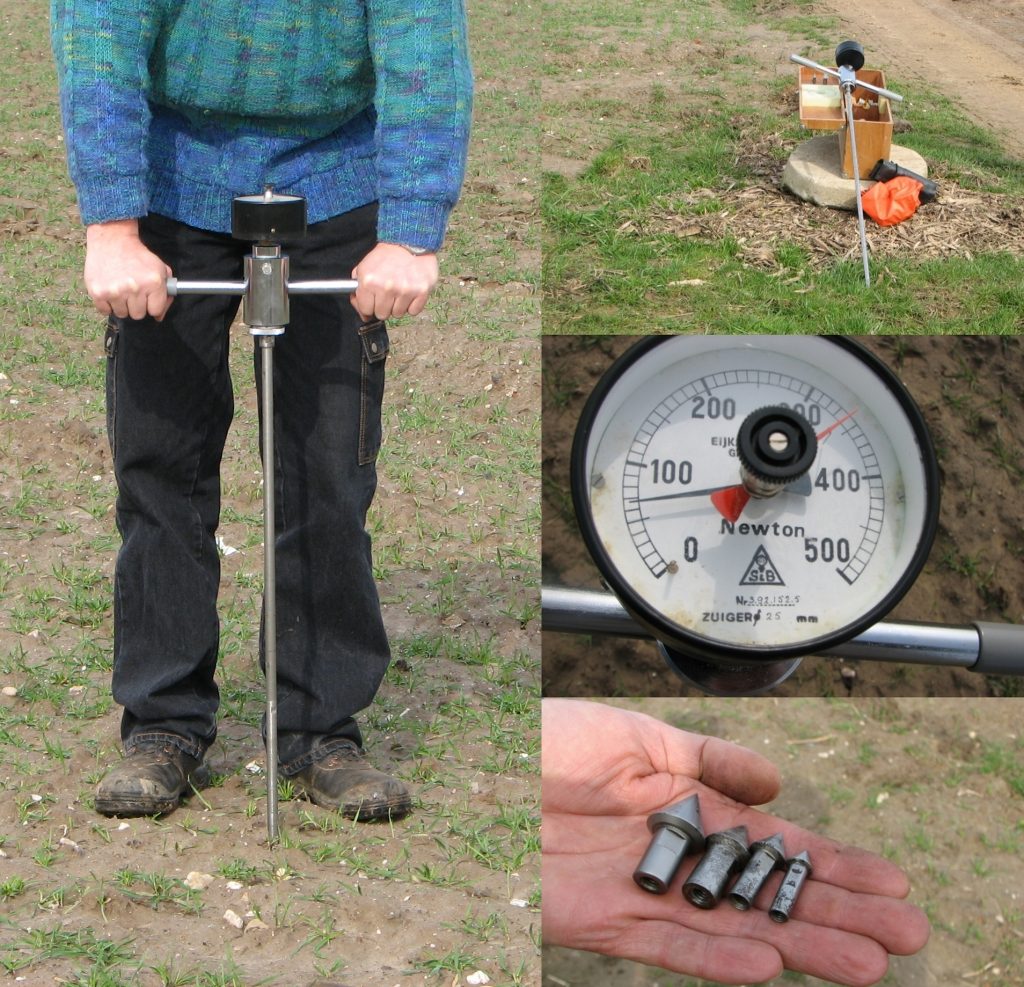6 Soil Health Assessment Part IV: Soil Penetration Resistance and Plant Roots
Soil Penetration Resistance and Plant Roots
Acknowledgement and Recommended Reading
This laboratory was designed to conduct in-field assessments of soil health and is based on the Cropland In-Field Soil Health Assessment Guide from the USDA-NRCS (2021), and on the Pennsylvania State University extension publication, Diagnosing Soil Compaction Using a Soil Compaction (Soil Compaction Tester) by Duiker (2002). The video below from the University of Wisconsin Integrated Pest and Crop Management (2015) provides a demonstration on how to use a penetrometer. Methods and videos for the LandPKS app are provided for each activity below. More information is available at the LandPKS website (2023).
Learning Objectives
By the end of the laboratory you will:
- Conduct a field assessment to characterize soil penetration resistance and plant roots
- Determine need for conservation practices to address resource concerns associated with these soil health indicators
Materials
Materials required to complete this laboratory activity include the following:
- Wire flag, or
- Penetrometer
- Shovel or spade
- Hand lens
Introduction
Soil compaction can be caused by machinery or vehicle traffic, hoof traffic, or tillage. Soil compaction results in the loss of pore space, which limits aeration and water movement. Compaction can also inhibit or hinder root growth or interfere with soil organism habitat and nutrient cycling. Compaction can be indicated by increased soil penetration resistance as well as irregular root growth.
Penetration Resistance
Penetration resistance should be measured at field capacity if possible, due to the increase in soil strength as soil dries. Penetration resistance should be measured at 8-10 locations at the site, or 8-10 locations for each soil type or management system.
Wire Flag Method
Hold a wire flag near the flag and insert the wire to a depth of 30 cm (12 in) in an area known to not be compacted, such as a nearby fence row. Repeat this within the assessment area and determine if greater force was required to insert the wire. Record your observations in the data sheet.
Penetrometer Method
Penetrometers (Figure 6.1) are hand-powered instruments that measure the force exerted on a cone at the tip of a rod which is inserted into the soil.
Assess soil compaction by applying consistent, downward force at a rate of 2.5 cm (1 in) per second while observing readings on the pressure gauge. Cones should be used as follows: 0.5 in cones for silty, clayey, or loamy soils; 0.75 in cones for sandy soils. Note the depth of restrictive layers and resistance pressure. A layer of soil is considered restrictive to roots when penetration resistance exceeds 104 N/cm2 (1035 kPa, 150 PSI) in the top 15 cm (6 in) of soil and 207 N/cm2 (2070 kPa, 300 PSI) at 15-45 cm (6-18 in) of soil. Using Table 6.1, determine the compaction rating and whether subsoiling or an alternative practice is recommended based on the percent of observations where penetration resistance would be root limiting in the top 45 cm. Record your the results.

Table 1. Compaction rating determination based on observations of root-restrictive layers.
| Percent of Observations With a Root-Restrictive Layer Within Top 45 cm | Compaction Rating | Subsoiling or Alternative Practice Recommended |
|---|---|---|
| <30% | Light-none | No |
| 30-50% | Slight | No |
| 50-75% | Moderate | Yes |
| >75% | Severe | Yes |
Table adapted from (Murdock et al. 1995) and (Duiker 2002).
Assessing Penetration Resistance with LandPKS
Watch the following video for an overview of assessing soil penetration resistance using several methods and how to record penetration resistance data in LandPKS.
Plant Roots
Plants are the primary producers of terrestrial ecosystems, and plant roots are the primary means of carbon additions into the soil. This is done via root exudates from living plants, or decomposition of plant roots once a plant dies or sheds roots. These exudates and root-derived carbon feed soil microbes. The roots also promote soil aggregation and create biopores, thus influencing soil porosity, aeration, water movement, nutrient cycling, and soil organism habitat.
To assess plant roots as a soil health indicator observe rooting patterns in the top 20 cm (8 in) or deeper depending on the plants present and soil conditions. Roots should be abundant and be deeply rooted, and not be impeded by compacted layers as indicated by kinked or irregular root growth or roots growing horizontally above a compacted layer. Healthy roots should have root hairs, whereas a lack of root hairs may indicate anaerobic soil conditions. Roots should be intermingled with soil aggregates that stick to the roots, indicating roots and root hairs are supporting soil structure. Some plant species may form rhizosheaths, which can indicate beneficial soil microbe colonization. Record your observations in the data sheet.
Assessing Plant Roots with LandPKS
Watch the following video for an overview of assessing soil roots and recording data in the LandPKS app.
Questions
The following questions directly relate to this lab activity and will be answered as part of the Site Evaluation and Soil Health Assessment Report.
- Did any of the soil health indicators above not meet the soil health assessment criteria? Explain why.
- Where there any recent operations or site conditions that may have influenced any of the soil health assessments? Explain how the assessments may have been impacted.
References
Duiker, S. W. 2002. Diagnosing Soil Compaction Using a Penetrometer (Soil Compaction Tester). Pennsylvania State University. https://extension.psu.edu/diagnosing-soil-compaction-using-a-penetrometer-soil-compaction-tester.
LandPKS. 2021a. SoilHealth Trainings 6: Root Restriction (Penetration Resistance). https://youtu.be/EouDj8P7a4U.
LandPKS. 2021b. SoilHealth Trainings 10: Plant Roots. https://youtu.be/YAbmhJ1VZaY.
LandPKS. 2023. LandPKS. https://landpotential.org/.
Schoeneberger, P. J., D. A. Wysocki, E. C. Benham, and Soil Survey Staff. 2012. Field Book for Describing and Sampling Soils, Version 3.0. Lincoln, NE: USDA-NRCS. https://www.nrcs.usda.gov/resources/guides-and-instructions/field-book-for-describing-and-sampling-soils.
University of Wisconsin Integrated Pest and Crop Management. 2015. Using a penetrometer to detect soil compaction. Arlington, Wisconsin. https://youtu.be/Zq_785JqRq8.
USDA-NRCS. 2021. Cropland In-Field Soil Health Assessment Guide. USDA-NRCS. https://www.nrcs.usda.gov/wps/portal/nrcs/detailfull/national/soils/health/?cid=nrcs142p2_053869.
USDA-NRCS. 2022. Conservation Practices. https://www.nrcs.usda.gov/wps/portal/nrcs/detailfull/national/technical/cp/ncps/?cid=nrcs143_026849.

